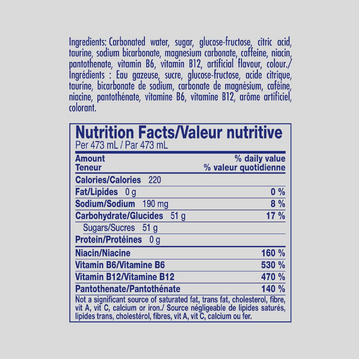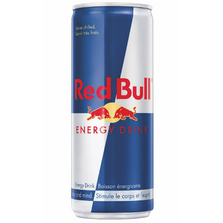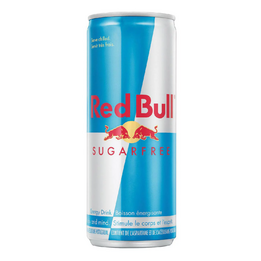Course:FNH200/Assignments/2023/RedBull EnergyDrink OriginalVsSugarFree
Appearance
This is the submission for Assignment #2 by team 10.
Briefly introduce your food products
Red Bull is a famous energy drink. Originating from Austria, it is a highly consumed product across the globe. Our investigation here aims to compare and contrast the compositions of the classic Red Bull and the sugar-free Red Bull.
Post pictures (Mandatory)




Ingredient lists (4 points)
- Type out the lists of ingredients:
- Red Bull: Carbonated Water, Sucrose, Glucose, Citric Acid, Taurine, Sodium Bicarbonate, Magnesium Carbonate, Caffeine, Niacinamide, Calcium Pantothenate, Pyridoxine HCI, Vitamin B12, Natural and Artificial Flavors, Colors.
- Sugar Free Red Bull: Carbonated water, citric acid, taurine, sodium bicarbonate, magnesium carbonate, caffeine, acesulfame-potassium, aspartame (contains phenylalanine), niacin, pantothenate, vitamin B6, vitamin B12, xanthan gum, artificial flavor, color. Contains per 250 ml: 50 mg acesulfame-potassium, 50 mg aspartame.
- Identify fat substitutes, sugar substitutes, and/or additives used, if there is any
- Explain the roles of fat substitutes, sugar substitutes, and/or additives used in terms of the functional properties they contribute to the produc
- Aspartame- a sweetener that is composed of 2 amino acids and due to its abilities to bind to sweet taste receptors with high affinity, meaning that it will allow for aspartame to be far sweeter than table sugar (180-220 times) and even greater than glucose. Furthermore, due to the reduced amount of aspartame needed to sweeten the drink in culmination with other sugar alternatives one can reduce calories greatly using this method. Once the dissociation of the aspartame occurs there is a release of 4 Cal per gram and we are left with 2 Amino Acids Phenylalanine and aspartic acid both of which can be absorbed by the body to act as substrates for various protein based functions. This is important as this will not have an insulinogenic effect or affect blood glucose greatly which is a great alternative for someone with Type 2 Diabetes Mellitus to drink.
- Acesulfame K, this a “no calories” sweetener, while it does have the ability to produce thermodynamic reaction that can measured to gain calorie readings, our bodies are not able to metabolize this sugar simply due to the fact that we do not have the enzymes to process this, we only have the receptors on the tongue that is able to bind and create the sensation of sweetness. This specific sweetener is known to be 200 times sweeter than table sugar and it is neither metabolized by our human gut, gut biota, or oral biota, hence this will neither increase the calorie count towards our food but it will also not be a fermentable sugar creating acidic compounds that can decay tooth enamel. In addition, Acesulfame K is known to increase insulin release and contribute to insulin resistance, hence this is to be used with other sweeteners to ensure that insulinogenic effect occurring is mitigated to some extent as you will not need to add large amount of this substance alone to sweeten the material.
- Additives
- Citric acid is used for flavoring, preservation and has antimicrobial properties. The acid will be detected by tongues receptors giving a sour taste.
- Sodium Bicarbonate, is a agent that is used to balance and buffer pH to ensure that the material is not extremely acidic and will increase pH or ensure the pH will not drop heavily.
- Magnesium Carbonate is used in a similar process to Sodium Bicarbonate
- Compare and contrast the lists of the two products and explain differences:
Labels (1 points)
- Provide detailed description of the information found on the labels
- Indicate whether the information complies with the regulatory requirements as outlined in Lesson 04.
| Regulatory Requirement | Red Bull | Red Bull Zero Sugar |
| Bilingual Labelling | French and English are on the label. | French and English are on the label. |
| Common Name of the Food | Red Bull Energy Drink | Red Bull Zero |
| Country of Origin | “Imported by Red Bull Canada Ltd 110-1128 Homer St, Vancouver, BC V6B 6M5,” is labeled without specifying where the cans were imported from. | ”Imported by Red Bull Canada Ltd 110-1128 Homer St, Vancouver, BC V6B 6M5,” is labeled without specifying where the cans were imported from. |
| Date markings and storage instructions | ”Best before date" labeled on the bottom of can; there are no storage instructions | ”Best before date" labeled on the bottom of can; there are no storage instructions |
| Identity and principal place of business | Says “Imported by Red Bull Canada Ltd 110-1128 Homer St, Vancouver, BC V6B 6M5 | Says “Imported by Red Bull Canada Ltd 110-1128 Homer St, Vancouver, BC V6B 6M5 |
| Irradiated foods | irradiated foods are not mentioned | irradiated foods are not mentioned |
| Legability and location | The label is printed directly on the can. All of the information on the product is legible. | The label is printed directly on the can. All of the information on the product is legible. |
| Nutrition facts table | The Nutrition Facts table is on the back of the can. The table provides the calories, the amount of fat, sodium, carbohydrates, protein, niacin, vitamin B6, vitamin B12, and pantothenate. | The Nutrition Facts table is on the back of the can. The table provides the calories, the amount of fat, sodium, carbohydrates, protein, niacin, vitamin B6, vitamin B12, and pantothenate. |
| Net quantity of the food | 250 mL (1 can) | 250 mL (1 can) |
| Sweeteners | No artificial sweeteners. Has sugar and glucose-fructose in the ingredients list. | Can has “Contains Acesulfame-Potassium and Sucralose” in big bold letters at the bottom of the front of the can in both French and English. |
| Nutrient content claims and diet-related health claims | "Not a significant source of saturated fat, trans fat, cholesterol, fibre, vit A, vit C, calcium, or iron" | "Not a significant source of saturated fat, trans fat, cholesterol, fibre, vit A, vit C, calcium, or iron" |
Personal Choice (5 points)
Please submit your individual component of this assignment on Canvas to protect your privacy and your personal opinion
References
Please use the Wikipedia reference style. Provide a citation for every sentence, statement, thought, or bit of data not your own, giving the author, year, AND page.
Note: Before writing your wiki article on the UBC Wiki, it may be helpful to review the tips in Wikipedia: Writing better articles.[1]
- ↑ En.wikipedia.org. (2018). Writing better articles. [online] Available at: https://en.wikipedia.org/wiki/Wikipedia:Writing_better_articles [Accessed 18 Jan. 2018].
| This Food Science resource was created by Course:FNH200. |
